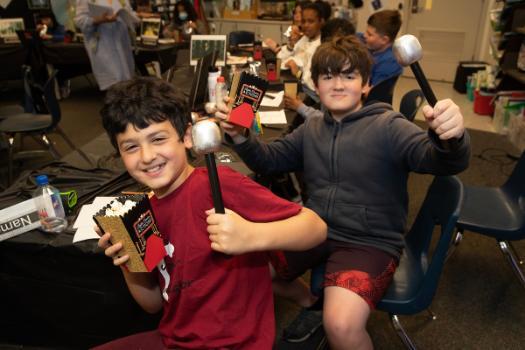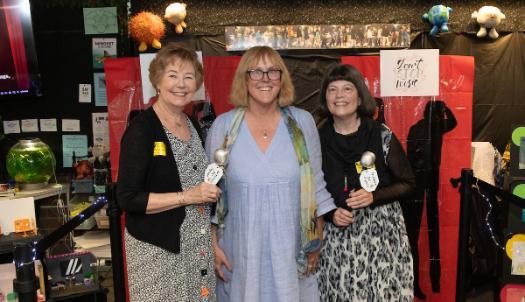In Tune with Civic Engagement
Written by Written by Tina Potterf
Thursday, June 22, 2023
/114x0:1086x620/prod01/channel_34/media/newsroom/COE-storypath-classroom-group.jpg)
College of Education professor designs teaching units that make learning social studies meaningful, interactive and fun.
Music has the power to provoke an emotional response, recall a memory, uplift and inspire, be anthemic and activate a movement. It can cement the voice of a generation or be the “song of the summer.” Music is a mainstay of so many pivotal points throughout a lifetime and has provided the soundtrack to historical periods from the Civil Rights Movement to the 1963 March on Washington. As the late congressman and civil rights leader and icon John Lewis once said, “If it hadn’t been for music, the Civil Rights Movement would’ve been like a bird without wings.”
Using different topics, such as music, and story-making to teach and learn about social studies and civics form the core of Storypath, a K-8th grade, unit-based program first developed in the 1960s in Scotland and for the past 24 years brought stateside to local and national schools by College of Education Professor Margit McGuire, PhD. It was a chance encounter on a plane when McGuire struck up a conversation with a publisher of math units and the lightbulb moment was that she could create and publish these interactive units around social studies for a national audience.

The fifth graders—and perhaps future Grammy Award winners?—of Hazelwood Elementary School.
While McGuire is the force behind creating the framework for these instructional units, before they are published and made available for educators everywhere she works with teachers during a pilot process where they can help shape the contours of the unit through trial and error, figuring what works for a specific classroom or students and then adapt accordingly.
For her latest Storypath unit, McGuire collaborated with College of Education colleague Laurie Stevahn, PhD, who teaches Educational Research and Social Justice courses, in creating “Civic Engagement and the Power of Music.” The mission is to have students create music that inspires people to engage in the civic process or to advocate to right an injustice.
“Music and the arts always play a key role in social justice issues,” says Stevahn.
This unit is composed of five objectives: learn about the history of music and how it influences people to take action; brainstorm topics; research the chosen topic; write a song based on the subject matter; and share that song with others to change hearts and minds.
The lesson goes beyond just songwriting as it covers the spectrum of the music industry—from instrumentation, songwriting and copyright to audio engineering, production and publishing rights—while connecting it back to a past or present period.
“I always seek out highly diverse, low-income schools as they don’t always get social studies and I feel all kids deserve a really good curriculum,” says McGuire. “What gets me excited is the kids who you least expect to excel are transformed by the experience. This gives them agency.”
This spring, McGuire was team-teaching and piloting the unit alongside Barbara Bromley, a 5th grade teacher at Hazelwood Elementary School in Lynnwood. Students in small groups contributed to creating a music studio and through the process learn about collaboration and teamwork, problem solving and critical thinking. Plus, in the case of this unit, students participate in a culminating performance and presentation of their songs.

(l-r) College of Education Professor Margit McGuire, Hazelwood Elementary School teacher Barbara Bromley and College of Education Professor Laurie Stevahn.
Bromley has taught McGuire’s Storypath units previously and following a meeting in December at a conference, the two connected. Teaching social studies through music made perfect sense for Bromley, whose students love music and know how it can infuse and shape personal experiences and circumstances.
“They have experienced war, immigration, drugs and more firsthand. I knew they would be passionate about making a difference,” says Bromley. “Additionally, we have been working on a yearlong project with our city mayor. We have been participating in civic action projects such as improving the traffic accessibility issue near our school, learning about government and how it functions and how to write mayoral speeches. This project provides them with another way to be active in their community.”
When composing this unit and its focus on music, McGuire worked closely with Stevahn, who spent hours researching and listening to songs and learning what existing songs are in the public domain and therefore could be used for purposes of instruction. McGuire made a connection with a person in the music industry in New York to review the unit as an expert—something that is done with each unit before it’s published. This contact proved especially beneficial as it helped in framing music not so much for the money and fame that can come with a hit song but rather music for impact, social justice and civil engagement.
In Bromley’s class, students created songs covering topics including deforestation, wildfires, gun control, drugs, immigration, war, freedom of religion, animal rights and plastics in the ocean.
“My students are connecting with social studies by becoming citizens themselves throughout the unit. They utilized 21st century skills of collaboration, creativity, communication and critical thinking,” says Bromley, from working in teams to write lyrics to designing their music and analyzing primary resources like images and interviews that can help in marketing their work.
Students are encouraged to spread the music beyond the classroom
“We are asking kids to be civically engaged—record their music and send it to the governor or a senator or the Human Rights Commission,” says McGuire, who is also working with a teacher in Yakima who is going to pilot this program for fourth graders. “In the end we want students to see that their voice matters.”
On May 31, Bromley’s class presented their original songs and shared their music studio journey in a Grammy Awards-style performance and awards ceremony.
For Bromley, there were several key takeaways from this Storypath experience.
“Witnessing my students overcome matching lyrics to their chosen melodies and overcoming performance anxiety when singing their songs,” she explains. “And compromising on what items go into their music studio rooms, while understanding that music motivates people to want to take action or be a part of a movement.”
There are countless students across the country who have been part of Storypath through the years and McGuire says she often hears from them years later, carrying forth the lessons instilled in them through the unit. One of those students became involved in the 2016 presidential election and another ran for office. One staffer on a campaign shared with McGuire that it was Storypath that inspired her future path.
“Storypath is Margit’s legacy,” says Stevahn.
Contact Listing
/0x58:1200x1443/prod01/channel_34/media/seattle-university/directory/faculty-amp-staff-directory/images/education/Margit-E_c8X10_1200X1500.jpg)
/0x20:1900x1220/prod01/channel_34/media/seattle-university/news-amp-stories/magazine/fall-2025/Landing-Page-Hero_2.jpg)
/0x42:2400x1558/prod01/channel_34/media/seattle-university/news-amp-stories/images/ChrisWhidbeyChemistry_yk_014.JPG)
/65x0:1124x669/prod01/channel_34/media/seattle-university/news-amp-stories/images/ISU-Presidential_Speaker_Series_-Stephen_Macedo_KP-77-(1).jpg)